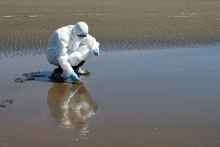
#17,159
Although primarily north-south conduits, these migratory flyways have enough overlap to allow for east-west transmission of avian viruses as well, meaning that the whole South American continent is at risk.
Global Flyways – Credit FAO
The announcement from the Chilean MOA follows.
Minister Valenzuela confirms the first case of H5N1 avian influenza in a wild bird found in Arica
Wed, 12/07/2022 - 19:09
After the increase in active surveillance, the laboratories of the Agricultural and Livestock Service confirmed a positive case of high pathogenicity. Collaborations with other state agencies and the private sector were strengthened to strengthen biosafety measures.
The Minister of Agriculture, Esteban Valenzuela, together with the national director(s) of the Agricultural and Livestock Service (SAG), Andrea Collao, confirmed today the presence of a case of highly pathogenic avian influenza in a wild bird found in Arica. This corresponds to the H5N1 variant, which has already been detected in Ecuador, Peru, Colombia and Venezuela.
The authority revealed that, given the complex scenario that this disease had been showing on the continent, in Chile the SAG had already been working between the public and private sectors to mitigate possible negative effects on the productive matrix of the poultry industry, which up to the minute is not affected by this finding.
"We want to inform you that today the Agricultural and Livestock Service, deployed on alert throughout the entire time to determine if avian influenza has arrived in Chile, has definitively detected that it arrived in a wild bird that was discovered in poor condition in the region. of Arica and Parinacota”, said the Secretary of State.
The SAG for several months had been reinforcing surveillance and activating its alert systems throughout the country since positive cases of Highly Pathogenic Avian Influenza (HPAI) were detected on the continent.
This, as Valenzuela explained, is part of a global process. "In North America, Europe and the countries of the Latin American coast as a result of the migrations of wild birds, an increase in cases of avian influenza has been detected from the north and south, as we have verified in the Arica region and Parinacota (…) we have worked with the poultry and egg industry, with the Ministry of the Interior, with the Ministry of Health and various public departments to provide maximum vigilance and support in this situation”.
The Agricultural and Livestock Service is working with all the actors in the poultry production chain to increase biosecurity measures, in a public-private partnership. “We are prepared, rest assured. This does not affect the consumption of poultry or their export. The same goes for egg production in our country. We ask each of the places supervised by the SAG for joint responsibility and cooperation in this process," Valenzuela said.
Finally, the Secretary of State made a call to the public that “in the event of any observation of sick birds, they must communicate it to the available channels of the SAG. We ask you not to handle sick or dead birds in any case."
The contact channels to make these complaints are the following: 2 2345 1100 / +56 9 690 89 780 or write to oficina.informaciones@sag.gob.cl .
The introduction of HPAI H5 to a new continent provides this avian flu virus with access to millions of immunologically naive wild birds, and to an array of LPAI viruses with which to reassort.
HPAI H5 evolves easily and often (see Preprint: Rapid Evolution of A(H5N1) Influenza Viruses After Intercontinental Spread to North America), meaning new, and potentially more dangerous, variants may emerge.Despite 4 known (mild) human infections, the health threat to the general public from these HPAI H5 viruses remains very low, and it is mainly of concern to those who work closely with poultry.
That could change of course, should the virus develop additional mammalian adaptations, which is why we follow the spread and impact of these viruses so closely.


